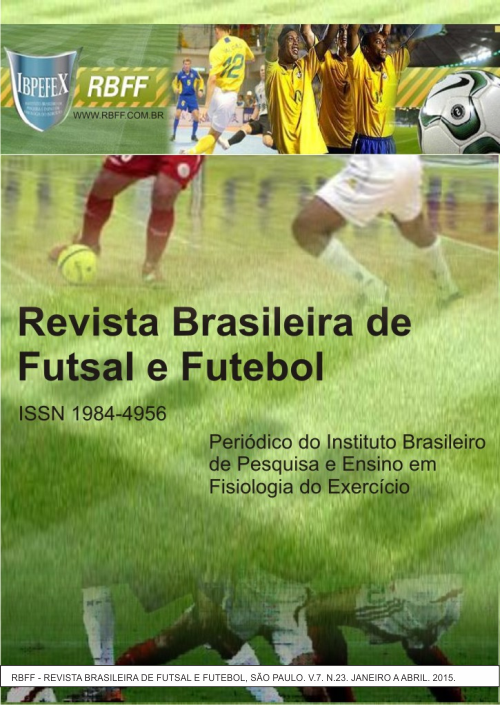Analysis of ball possession time and its influence in results of Futsal World Championship
Abstract
The aim of the study was to compare the average percentage of possession ball time between the results of victory and defeat, general and stratified by stage, in games Futsal World Championship. The sample consisted of data from tables published on the official FIFA website (www.fifa.com), containing information on these variables, presented in percentages and absolute values. 52 official games in world championship at 2012 conducted in Thailand, with the participation of 24 teams were analyzed. To compare the average of time possession between the results we used the Student t test for independent samples. The level of significance was set at 0.05 and the software used in the analysis was SPSS V.20. Results: At the general, the average percentage of time possession of winner team was 51.44 ± 8.404%, and the average time the team that was defeated was 48.56% ± 8,404. Only in the group stage were significant in the average percentage of the ball, win 47.09 ± 7.768 differences; defeat 52.91 ± 7.768, (p = 0.004). Conclusion: The outcome of the game, victory and defeat, is not explained only by the average percentage of the ball possession, however, it is possible that it can help if combined in other variables situational, although these have not been the object of this study, as income level of the teams, score of the game and momentary emotional athlete state.
References
-Andrade, J. R. O jogo de futsal técnico e tático na teoria e na prática. Curitiba: Expoente, 1999.
-Bello Junior, N. A ciência do esporte aplicada ao futsal. Rio de Janeiro: Sprint, 1998.
-Bueno, L.; Alves, I. P. Análise dos gols na primeira fase da liga de futsal 2012. Revista Brasileira de Futsal e Futebol, São Paulo, Vol. 4. Núm. 12. 2012. p. 118-123. Disponível em: <http://www.rbff.com.br/index.php/rbff/article/view/135/131>
-Ganef, E.; Reis, F. P. C.; Almeida, E. S.; Navarro, A. C. Influência do Goleiro-Linha no Resultado do Jogo de Futsal. Revista Brasileira de Futsal e Futebol, São Paulo. Vol. 1. Núm. 3. 2009. p. 186-192. Disponível em: <http://www.rbff.com.br/index.php/rbff/article/view/24/24>
-Gréhaigne, J.; Bouthier, D.; David, B. Dynamic-system analysis of opponent relationship in collective action in soccer. Journal of Sports Science. Vol. 15. 1997. p. 137-149.
-Hughes, M.; Franks, I. Systems for Beter Coaching and Performance in Sport. Notational Analysis of Sport. London. Vol. 2. 2004.
-Kumahara, R.; Barbieri, F. A.; Leme, J. A.; Machado, A.A. Análise qualitativa das ações e do sistema de jogo de equipes profissionais de futsal. Coleção Pesquisa em Educação Física. Vol. 8. Núm. 1. 2009. p. 65-70.
-Leite, W. S. S. Relação Entre o Primeiro Gol e o Resultado Final do Jogo de Futsal na Copa do Mundo de 2012. Revista Brasileira de Futsal e Futebol, São Paulo. Vol. 6. Núm. 19. 2014. p. 32-36. Disponível em: <http://www.rbff.com.br/index.php/rbff/article/view/234/21>
-Marchi, R. V.; Silva, C. E.; Scramin, L. R. R.; Teixeira, A. A.; Chiminazzo, J. G. C. Incidência de Gols Resultantes de Contra-Ataques de Equipes de Futsal. Revista da Faculdade de Educação Física da UNICAMP, Campinas. Vol. 8. Núm. 3. 2010. p. 16-22.
-Santana, W. C.; Garcia, O. B. A Incidência do Contra-Ataque em Jogos de Futsal de Alto Rendimento. Revista Pensar a Prática, UFG. Vol. 10. Núm. 1. 2007.
-Santana, W. C. Futsal: Apontamentos Pedagógicos na Iniciação e na Especialização. 2ª edição. Campinas. Autores Associados, 2008.
-Thomas, J. R.; Nelson, J. K.; Silverman, S. J. Métodos de pesquisa em atividade física. 5ª edição. ArtMed. 2007
-Tourinho Filho, H.; Soares, B.; Barbanti, V.J. Análise do Desempenho em Quadra de Jogadores de Futsal: Um Estudo Longitudinal. Revista Digital. Buenos Aires. Ano 14. Núm. 141. 2010.
-Voser, R. C.; Giusti, J. G. O futsal e a escola: uma perspectiva pedagógica. ArtMed. 2002.
-Voser, R. C. Futsal: princípios técnicos e táticos. 3ª edição. Canoas. ULBRA. 2011.
Authors who publish in this journal agree to the following terms:
- Authors retain the copyright and grant the journal the right of first publication, with work simultaneously licensed under the Creative Commons Attribution License BY-NC which allows the sharing of the work with acknowledgment of the authorship of the work and initial publication in this journal.
- Authors are authorized to enter into additional contracts separately for non-exclusive distribution of the version of the work published in this journal (eg, publishing in institutional repository or book chapter), with acknowledgment of authorship and initial publication in this journal.
- Authors are allowed and encouraged to post and distribute their work online (eg, in institutional repositories or on their personal page) at any point before or during the editorial process, as this can bring about productive change as well as increase impact and impact. citation of published work (See The Effect of Free Access).





